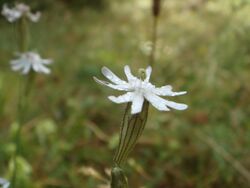Biology:Silene italica
| Silene italica | |
|---|---|

| |
| Scientific classification | |
| Kingdom: | Plantae |
| Clade: | Tracheophytes |
| Clade: | Angiosperms |
| Clade: | Eudicots |
| Order: | Caryophyllales |
| Family: | Caryophyllaceae |
| Genus: | Silene |
| Species: | S. italica
|
| Binomial name | |
| Silene italica (L.) Pers.
| |
| Synonyms | |
| |
Silene italica is a species of plant native to Southern Europe and parts of Asia. It is also introduced to parts of the United States and Northern Europe.
Silene italica is similar to Silene nutans[1] and contains various subspecies.
Common names
In English, it goes by the common name Italian catchfly.[2] While in Denmark it is called Italiensk limurt and in Germany it is called Italienisches Leimkraut.[3]
Etymology
Silene is the feminine form of Silenus, an Ancient Greek woodland deity who was the companion and tutor to the wine god Dionysus.
Italica is the feminine form of Italicus, meaning "of Italy"
Subspecies
The following is a list of subspecies for S. Italica.
- Silene italica subsp. italica[4]
- Silene italica subsp. peloponnesiaca
- Silene italica subsp. sicula
- Silene italica subsp. coutinhoi[5]
- Silene italica subsp. nemoralis
- Silene italica subsp. puberula[6]
Characteristics
It can grow up to 40 cm or 80 cm high and the stems are erect. The species has kidney-shaped seeds.[7] The petals on the flowers can be pink, white, or yellow.[8]
Sexual system
It is gynodioecious–gynomonoecious and has a low frequency of female plants.[9] Gynomonoecious individuals are common in the species and make up to 40% of the population.[10]
Floral scent
A study from 2002 found that both terpenoids and benzenoids were dominating over the floral scent of S. Italica.[11] The study also found that chemical composition of S. Italica’s floral scent is
- 2.2% benzyl alcohol
- 9% benzyl acetate
- 14.5% linalool
- 9% methylbenzoate[11]
Distribution and habitat
Plants of the World Online says is native to places like Albania, Bulgaria, Cyprus, Italy, Spain, Iran, Italy, Greece, Turkey, Ukraine, Yugoslavia, Palestine, Turkmenistan, Romania, and France and that it is present in Corsica, Denmark , Great Britain, and Germany but not native.[4]
But the Centre for Agriculture and Bioscience International says that it was introduced to Belgium with it first being reported in 1918 and is also present in Austria and Slovakia.[3]
According to the United States Department of Agriculture, it was introduced to New Jersey and New York.[12]
Throughout the Mediterranean region, S. Italica occurs in hedges as well as open woodlands.[13](p162) In southern France it is commonly found in the garrigue.[10]
In Britain, it naturally occurs on chalky roadside banks and chalk quarries between Dartford and Greenhithe. It was first cultivated on the island in 1759 but was first found in the wild in 1863.[1]
References
- ↑ 1.0 1.1 "Silene italica | Online Atlas of the British and Irish Flora". https://plantatlas.brc.ac.uk/plant/silene-italica.
- ↑ "ITIS - Report: Silene italica". https://www.itis.gov/servlet/SingleRpt/SingleRpt?search_topic=TSN&search_value=565516#null.
- ↑ 3.0 3.1 "Silene italica" (in en). https://www.cabi.org/isc/datasheet/117144.
- ↑ 4.0 4.1 "Silene italica (L.) Pers. | Plants of the World Online | Kew Science" (in en). http://powo.science.kew.org/taxon/urn:lsid:ipni.org:names:157576-1.
- ↑ "Silene italica (L.) Pers. — The Plant List". http://www.theplantlist.org/tpl1.1/record/kew-2488103.
- ↑ "Catalogue of Life - 2014 Annual Checklist :: Species details". http://www.catalogueoflife.org/annual-checklist/2014/details/species/id/16882668.
- ↑ Bojnanský, Vít; Fargašová, Agáta (2007-09-17) (in en). Atlas of Seeds and Fruits of Central and East-European Flora: The Carpathian Mountains Region. Springer Science & Business Media. pp. 73. ISBN 978-1-4020-5362-7. https://books.google.com/books?id=QSMe0qHGVaAC&dq=Silene+italica+habitat&pg=PA73.
- ↑ Stace, Clive (2010-04-01) (in en). New Flora of the British Isles. Cambridge University Press. pp. 471–472. ISBN 978-1-139-48649-1. https://books.google.com/books?id=nJ3YP28EjscC&dq=Italian+catchfly&pg=PA471.
- ↑ Casimiro-Soriguer, Inés; Buide, Maria L.; Narbona, Eduardo (2015-05-15). "Diversity of sexual systems within different lineages of the genus Silene". AoB Plants 7: plv037. doi:10.1093/aobpla/plv037. ISSN 2041-2851. PMID 25862920.
- ↑ 10.0 10.1 LAFUMA, LUCILE; MAURICE, SANDRINE (2006-04-01). "Reproductive characters in a gynodioecious species, Silene italica (Caryophyllaceae), with attention to the gynomonoecious phenotype". Biological Journal of the Linnean Society 87 (4): 583–591. doi:10.1111/j.1095-8312.2006.00597.x. ISSN 0024-4066. https://doi.org/10.1111/j.1095-8312.2006.00597.x.
- ↑ 11.0 11.1 Jürgens, A.; Witt, T.; Gottsberger, G. (2002-05-01). "Flower scent composition in night-flowering Silene species (Caryophyllaceae)" (in en). Biochemical Systematics and Ecology 30 (5): 383–397. doi:10.1016/S0305-1978(01)00106-5. ISSN 0305-1978. https://www.sciencedirect.com/science/article/pii/S0305197801001065.
- ↑ "USDA Plants Database". https://plants.usda.gov/home/plantProfile?symbol=SIIT.
- ↑ Jashemski, Wilhelmina Feemster; Meyer, Frederick G. (2002-09-19) (in en). The Natural History of Pompeii. Cambridge University Press. ISBN 978-0-521-80054-9. https://books.google.com/books?id=3xfjyTqqR7IC&dq=Silene+italica&pg=PA496.
Wikidata ☰ Q12217878 entry
 |

